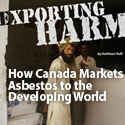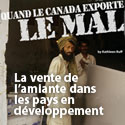 |
March 18, 2008
Dear Supporter,
The purpose of the U.N. Rotterdam Convention is to protect life and the environment by controlling trade in hazardous chemicals and pesticides.Now that these dangerous products, such as abestos, are being controlled or banned in the industrialized world, companies are aggressively targeting developing countries and the countries of Eastern Europe for expanded sales and increased profits.Although most Canadians do not know this, our government has been a world leader in sabotaging the Rotterdam Convention.In a 24 hour period, grass-roots groups from around the world signed the challenge below, calling on Canada and its handful of allies to stop sabotaging the Convention and put human life and the environment first.Please support them. If you haven’t already done so, send the letter to Prime Minister Harper calling for Canada to support the Rotterdam Convention and the World Health Organization call for a ban on asbestos.
PLEASE circulate this message widely.
In human solidarity and with gratitude to you,
Kathleen, Peggy, Pauline and Becky for RightOnCanada.ca
GLOBAL CAMPAIGN LAUNCHED
TO SAVE THE ROTTERDAM CONVENTION
U.N. Environmental Convention is being killed by political
and industry interference, say groups
2008 is the 10th anniversary of the adoption of the Rotterdam Convention, whose purpose is to protect human health and the environment by controlling international trade in hazardous chemicals and pesticides.
But instead of celebrating, a number of environmental, labour and health groups are sounding the alarm.
Industry interference and political sabotage by a handful of countries, led by Canada, are strangling the Rotterdam Convention, say the groups from Asia, Africa, South and North America, and Europe.
Because of this interference, action to implement the Convention has been obstructed and the groups are concerned that progress at meetings planned for this year will likewise be blocked.
Under the Convention, an expert body, called the Chemical Review Committee, recommends whether a hazardous product has met the criteria of the Convention and should be placed on a special list which requires countries to obtain Prior Informed Consent before they can export the product to another country.
The Convention, which has been ratified by 120 countries, came into effect in February 2004.
At its last meeting in 2006, over one hundred countries approved the recommendation made by the Chemical Review Committee that chrysotile asbestos be listed for Prior Informed Consent. But Canada, together with Kyrgyzstan, India, Iran, Peru and Ukraine, simply refused to let the Convention’s process work and blocked action on the recommendation.
They were supported by Zimbabwe, Russia and Indonesia, who have not ratified the Convention.
Canada argued that unless every single country agrees, no action should be taken to implement the Convention. “This is a death sentence for the Convention,” said Joan Kuyek of Mining Watch Canada.
The World Health Organization and the International Labour Organizations, among others, have called for chrysotile asbestos to be banned. Most industrialized countries have banned it. Asbestos companies are therefore aggressively targeting developing countries and the countries of Eastern Europe for expanded sales.
“If chrysotile asbestos, a known deadly carcinogen, which fully met all the requirements of the Convention can be prevented from being listed, then the Convention is in grave peril,” said Laurie Kazan-Allen of the Ban Asbestos International Secretariat.
“Industry interference is killing the Convention,” said Kathleen Ruff of RightOnCanada. “Countries allied to the asbestos industry are putting the profits of the industry ahead of the lives of people.”
“Industry is giving false information on chrysotile asbestos in the Eastern European and Central Asian countries, pretending that their local asbestos does not have the proven negative health effects. We have bought a few samples of asbestos on local markets, and the product is exactly the same as the asbestos which has been banned in most of the industrialized nations. We are very worried about the health of labourers in the building sector, and especially for children, as the asbestos is being used in public buildings like daycare centers and schools”, says Sascha Gabizon, executive director of Women in Europe for a Common Future.
“The Indian government even included a representative of the asbestos industry in its delegation,” said Madhumita Dutta of The Other Media. “And a study on asbestos presently being carried out by the Indian government was, in fact, funded by the asbestos industry.”
“At the March 10-13 meeting of the Convention’s Chemical Review Committee, taking place in Geneva right now, sixteen representatives from the chemical industry and, in particular, lobbyists for the asbestos industry will be attending as official observers,” noted Laurie Kazan-Allen. “Given the history of industry interference, this is extremely disturbing.”
We are calling for a stop to industry interference in a Convention meant to protect health and the environment, say the groups.
We are, in particular, challenging Canada, Kyrgyzstan, India, Kazakhstan, Iran, Peru and Ukraine, as well as Russia, Zimbabwe and Indonesia (who have not signed the Convention) to stop their irresponsible conduct.
Our message to them is – Stop the sabotage. Let the Convention do its job of protecting lives.
SIGNED:
*Abou Thiam, Pesticide Action Network Africa, Senegal
*Inga Zarafyan, President, EcoLur, Armenia
*Anabela Lemos, Director, JA! Justica Ambiental, Mozambique
*Natalya Abdullaeva, Women for Sustainable Development, Uzbekistan, Karakalpakstan
*Jim Turk, Executive Director, Canadian Association of University Teachers, Canada
*Eva Delgado Rosas, Coordinadora, Asociacion Frente al Asbesto, Perú
*Professor Igor Hadjamberdiev, Toxic Action network Central Asia, Kyrgyzstan
*Professor Ibragim Damulojanov, Toxic Action network Central Asia, Uzbekistan
*Professor Aiman Najmetdinova, Toxic Action network Central Asia, Kazakhstan
*Professor Muzofar Isobaev, Toxic Action network Central Asia, Tajikistan
*Madhumita Dutta, Corporate Accountability Desk-The Other Media, India
*Rico Euripidou, Research Manager, GroundWork, South Africa
*Elsa Nivia, RAPALMIRA, RAP-AL, Colombia
*Hon. Howard Pawley, Associate Professor Emeritus, University of Windsor and former Premier of Manitoba 1981-1988, Canada
*Sascha Gabizon, Executive Director, Women in Europe for a Common Future
*Anita Normark, General Secretary, Building and Woodworkers International
*Alexey Zimenko, Biodiversity Conservation Center, Russia
*Eliezer João de Souza, President, ABREA-Associação Brasileira dos Expostos
ao Amianto, Brazil
*Laurie Kazan-Allen, Coordinator, International Ban Asbestos Secretariat, UK
*Penchom Saetang, Campaign for Alternative Industry Network, Thailand
*Gopal Krishna, Ban Asbestos Network of India
*Fernanda Giannasi, Coordinator, Rede Virtual-Cidadã Pelo Banimento do Amianto para a América Latina, Latin America
*Irene Fernandez, Director, Tenaganita, Malaysia
*Robert Tumwesigye Baganda, Coordinator, Pro-Biodiversity Conservationists, Uganda
*Ram Charitra Sah, Executive Director, Center for Public Health and environment Development, Nepal
*Sena Alouka, Directeur Exécutif, Jeunes Volontaires pour l’Environnement, Togo, West Africa
*Sonia S. Mendoza, Chairman, Mother Earth Foundation – Philippines
*Joan Kuyek, National Coordinator, MiningWatch Canada
*Dr. Mahmood A. Khwaja, FCSP, Sustainable Development Policy Institute, Islamabad, Pakistan
*Islam Mustafaev, Prof of Chemistry, Chairman, Ecological Society Ruzgar, Azerbaijan
*Maria Gil-Beroes, Fundacion Aguaclara, Venezuela
*Ebeh A. Kodjo, Executive Coordinator, National Consumers & Environmental Alliance, Togo
*Sridhar Radhakrishnan, Thanal, Kerala, India
*Vladimir Garaba, Chisinau, Environmental Movement from Moldova
*Kathleen Burns, Ph.D., Director, Sciencecorps, U.S.A.
*Fe de Leon, Canadian Environmental Law Association, Canada
*Ilya Trombitsky, Executive Director, Eco-TIRAS, International Environmental Association of River Keepers, Moldova
*Silvani Mng’anya, Senior Programme Officer, AGENDA, Tanzania
*Manya Melikjanyan, Lore Eco Club/Armenia-Stepanavan
*Ban Asbestos Canada coalition, Canada
*Corneliu Busuioc, Oikos, National Association for Rural Development, Moldova
*Ellady Muyambi, General Secretary, Uganda Network on Toxic Free Malaria Control
*Linda Reinstein, Executive Director, Asbestos Disease Awareness Organization, U.S.A.
*Angela Bischoff, Director, Greenspiration, Canada
*Harry Glasbeek, Professor Emeritus & Senior Scholar, Osgoode Hall Law School, York University, Canada
*Jeni Mackay, Communities Against Toxics, Scotland
*Romeo F. Quijano, M.D., Professor, Dept. of Pharmacology andToxicology, College of Medicine, University of the Philippines, Manila
*Medha Chandra, Pesticide Action Network North America
*Dr Mariann Lloyd-Smith, National Toxics Network Inc &, International POPs Elimination Network,
Australia
*Kathleen Ruff, founder, RightOnCanada, Canada
*Pablo Liñan, Coordinador, Asociacion Peruana de Victimas del Asbesto, Peru
*Simplice Davo, VODOUHE
*Jamie Harvie, Executive Director, Institute for a Sustainable Future, U.S.A.
* Petru Botnaru, President, Terra-1530, Moldova
*Tony Clarke, Executive Director, Polaris Institute, Canada
*Dr. C.K. Durbak, Chair and CEO, World Information Transfer, Inc., U.S.A.
*Anne Kuersten, Tantramar Environmental Alliance, Canada
*Environmental Collective, University of Toronto, Canada
*Irina Balashova, Ecologicak Cenetr “TAU”, Kazakhstan
*Students Against Climate Change, University of Toronto, Canada
*Erik Jansson, President, Department of the Planet Earth, Inc., U.S.A.



April 17th, 2011 at 11:47 am
I was the first journalist to investigate and write in detail about the asbestos disease hazard, its cover-up by the asbestos industry, and the asbestos litigation that brought some measure of compensation to tens of thousands of asbestos victims. Ten of my articles on the subject were published in The New Yorker Magazine over a 20-year period, and they provided the contents for four books.
In 1992, I donated my collection of papers–much of it relating to my investigation of the asbestos hazard–to The New York Public Library. Five years later I was shown my papers, which were then shelved in the Library’s underground Bryant Park Extension Stacks, and told by the Library’s Curator of Manuscripts and Archives that they constituted my final collection.
In April 2010, Library officials informed me that they had deleted three-quarters of my collection (270 boxes worth!) and gave me the choice of having their contents sent to me within 30 days or destroyed by the Library. Much of the deleted material pertains to my investigation of the asbestos hazard.
Since then, Library officials have refused my repeated requests to return my collection to me in its entirety so I can donate it elsewhere.
As a result, I am asking professors of law, medicine, environmental and occupational health, as wells as public health officials, journalists, writers, scholars, union officials, asbestos attorneys, members of asbestos ban organizations, and victims of asbestos disease to write to Paul LeClerc, President of The New York Public Library, at PL@nypl.org, urging him to return my collection to me intact so that its unique and important contents can be donated elsewhere.
I am hoping that your members will heed this request.
An article describing what has happened to my collection of papers at the hands of The New York Public Library will appear on April 24, 2011, in The New York Sunday Times.
Sincerely,
Paul Brodeur